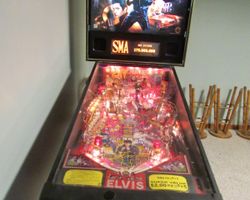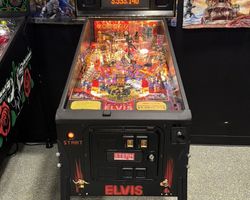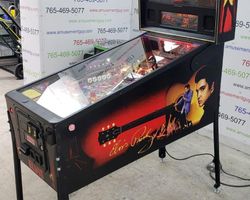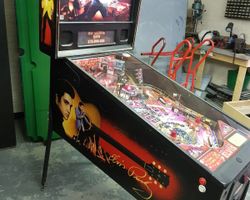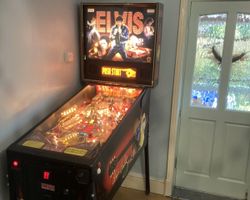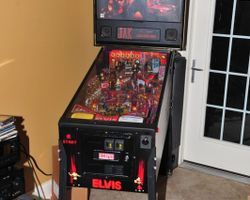Elvis
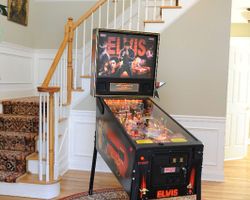
Average Prices: USD $2,400 to $5,500
Produced: August, 2004
Machine Type: Solid State Electronic
MPU: Stern Whitestar (modified)
Players: 4
Design by: Steve Ritchie
Art by: Jerry Vanderstelt
Music by: Chris Granner, Elvis Presley
Sound by: Chris Granner
Software by: Dwight Sullivan, Lonnie D. Ropp, Keith P. Johnson
When Stern Pinball, Inc. released its "Elvis" pinball machine in August 2004, it brought the energy of the King of Rock & Roll to the arcade. This game emerged as a significant licensed theme entry during a period when popular culture integrations were becoming a cornerstone of pinball design. Manufactured as model I-0084, it joined the Stern Whitestar (modified) generation of machines, a robust platform known for its reliability and versatility.
The design process for "Elvis" involved a team of experienced pinball creators. Steve Ritchie, a designer known for crafting fast-paced, flowing games, led the vision for the playfield and overall mechanics. The visual identity of the machine was shaped by artist Jerry Vanderstelt, whose work brought the iconic imagery of Elvis Presley to life on the cabinet and playfield. The crucial audio experience, integral to a music-themed game, was masterfully handled by Chris Granner, responsible for both the music and sound design. Software development was a collaborative effort, with Dwight Sullivan, Keith P. Johnson, and Lonnie D. Ropp programming the game's modes and rules, while Mark Galvez handled the animations displayed on the dot matrix display (DMD).
Production for the standard "Elvis" machine numbered 3,500 units, a substantial run for the time. An additional 500 "Elvis Gold" Limited Edition machines were produced, featuring gilded trim and an aftermarket shaker motor, offering a more exclusive version for dedicated collectors. A distinctive element of the game’s audio presentation is the use of actual Elvis recordings from his '68 Comeback television special and the 'Aloha from Hawaii' television special. Tracks such as "See See Rider", "Blue Suede Shoes", "All Shook Up", "Hound Dog", "Jailhouse Rock", "Heartbreak Hotel", and "Burning Love" are prominently featured. Notably, the game integrates the first 5-10 seconds of these songs as actual recordings before transitioning to MIDI-sequenced reproductions. Adding another layer of authenticity, the custom speech in the game was provided by Elvis fan and voice actor Jamie Aaron Kelley, with his father, Larry Kelley, lending his voice as the radio announcer. The concert announcer for the game is none other than Al Dvorin, Elvis's original concert announcer and the originator of the phrase "Elvis has left the building," tying the pinball experience directly to Presley's live performances.
Signature Features and Design
The "Elvis" pinball machine is characterized by several distinctive elements that elevate its thematic integration and gameplay experience. Central to its appeal is the mechanical Elvis figure positioned prominently on the playfield. This detailed toy, designed with shaking hips and gesturing hands, moves forward and backward in perfect synchronization with the game's soundtrack, bringing the microphone to the King of Rock & Roll’s lips with each sung phrase. This kinetic element serves as a captivating focal point, providing a miniature concert spectacle that directly responds to the game's audio cues.
Beyond the animated figure, the game’s soundtrack stands as a cornerstone of its design. The inclusion of genuine recordings from Elvis's acclaimed television specials ensures an authentic audio experience for players, immediately immersing them in the world of Elvis Presley. The custom voice work, including contributions from Jamie Aaron Kelley and the original concert announcer Al Dvorin, further enhances this immersion, delivering callouts and announcements that resonate with the King's legacy. The game's Dot Matrix Display (DMD) animations complement the playfield action, providing visual feedback and narrative progression that tie into the various song modes and objectives. The overall artwork, primarily by Jerry Vanderstelt, is vibrant and visually appealing, adorning both the cabinet and the playfield with evocative imagery of Elvis in various performance poses, setting a lively and dynamic stage for play. These features collectively aim to create an experience that feels less like a pinball game and more like a tribute concert, engaging players through both visual and auditory spectacle.
Playfield and Mechanics
The playfield of "Elvis" is a multi-leveled design by Steve Ritchie, known for its emphasis on flow and satisfying shot geometry. The main playfield features a conventional arrangement of three pop bumpers, positioned to keep the ball active and create chaotic scoring opportunities. Two slingshots at the lower sides of the playfield provide dynamic rebounds into the upper half. The game incorporates four flippers in total, strategically placed to offer diverse shot angles and control. Three flippers manage the primary playfield, guiding shots towards ramps and targets, while a fourth flipper is dedicated to navigating the upper playfield.
Key to the game's shot variety are its two metal ramps, which provide smooth, looping shots that are both satisfying to execute and crucial for progressing through game modes. A five-bank drop target setup challenges players to hit specific targets to unlock features or light modes. A spinner target offers high-scoring opportunities when spun rapidly, contributing to the game's overall score potential. Additionally, two saucers are present, often used for initiating modes or collecting bonuses. A single magnet on the playfield can temporarily alter ball trajectory, adding an element of unpredictability and strategic depth.
A prominent feature is the clear upper playfield. While it offers an elevated play area, its integration into the overall game flow has elicited mixed responses. The layout's philosophy aims for a fast-paced experience, characteristic of Ritchie's designs, with shots designed to keep the ball in motion and provide a sense of progression through the various Elvis songs. The playfield artwork itself is visually rich, with bold colors and detailed renditions of Elvis, framed by concert stage elements and spotlights. This aesthetic, combined with dynamic lighting cues during gameplay, enhances the immersive concert atmosphere, guiding the player's focus to active shots and mode progression.
Gameplay Dynamics
The gameplay dynamics of "Elvis" are structured around the King of Rock & Roll's musical legacy, offering a progressive experience through his most famous songs. The Stern Whitestar (modified) MPU provides a robust platform for the game's rule set. Progression primarily involves initiating and completing "song modes," each tied to a specific Elvis hit. Players activate these modes by hitting designated shots and targets, with the objective to complete the requirements of the currently playing song before the ball drains or the song changes. This structure encourages players to focus on specific targets while listening to the iconic soundtrack.
The game features several multiball modes, the most prominent being "Heartbreak Hotel Multiball" and "Encore Multiball." Initiating these multiballs involves hitting specific targets or completing sequences, leading to multiple pinballs in play simultaneously, offering high-scoring opportunities and chaotic, engaging action. The ultimate objective for skilled players is to reach the "Graceland" Wizard Mode, a demanding challenge that requires completion of various game objectives and modes to unlock, serving as the game's climactic scoring opportunity.
A distinctive element of "Elvis" is its unique video mode. Unlike many traditional video modes, this one draws inspiration from rhythm-based games. Players must time their flipper presses with arrows moving across the Dot Matrix Display (DMD), mirroring the interactive timing challenges found in dance games. This novel approach provides a fresh break from conventional pinball play and further reinforces the game's musical theme. Player strategies often involve prioritizing specific song modes to maximize scoring, focusing on the drop targets to unlock features, and mastering the shots required to consistently hit the ramps and initiate multiballs. The integration of Elvis's actual recordings and custom callouts during gameplay ensures that every shot and mode progression feels directly tied to the King's performance, making the overall experience memorable for fans and players alike.
Reception and Legacy
The "Elvis" pinball machine by Stern has garnered a diverse reception within the pinball community, often described as a polarizing title where player enjoyment is heavily influenced by their affinity for Elvis Presley. For dedicated Elvis fans, the machine frequently receives high praise, being labeled as "underrated," "fun," and even a "must-have." This positive sentiment largely stems from the game's authentic integration of the Elvis theme, including his iconic music, original recordings, and custom callouts, which are consistently highlighted as significant strengths. The dancing Elvis figure is a particularly beloved feature, appreciated for its engaging animation and the humorous, interactive element it brings to the playfield. The vibrant artwork and smooth ball flow are also frequently cited as positive aspects, contributing to a generally enjoyable and family-friendly gameplay experience.
However, feedback from players less invested in the Elvis theme often presents a more measured view. Common criticisms include the upper playfield, which some find clunky, uninspired, or not adequately integrated into the primary gameplay loop. While the overall artwork is appreciated by many, some reviewers describe it as overly saturated, basic, or "cheesy." The audio quality, despite featuring original recordings, has also drawn some criticism, particularly regarding the transition from actual song clips to MIDI-sequenced reproductions, which can be perceived as a letdown. Gameplay balance is another area of mixed feedback; some players find the game too easy, leading to frequent multiballs, while others note that certain shots can be challenging to execute consistently. The ruleset has been described by some experienced players as overly simplistic, while others have found it confusing, indicating a potential lack of depth or clarity for different skill levels. Isolated critiques regarding the machine's build quality and materials have also surfaced.
Despite these varied opinions, the "Elvis" pinball machine holds a distinct place in pinball history, particularly for its role in showcasing the power of a highly integrated licensed music theme. It demonstrated that a strong, recognizable license, when paired with thoughtful design, could create a deeply immersive experience. While not universally acclaimed, its legacy is defined by its ability to capture the essence of Elvis Presley for his fans, solidifying its reputation as a machine that resonates strongly with a specific audience. The "Elvis" machine reinforced the potential for pinball to act as a dynamic, interactive tribute, an approach that has continued to influence subsequent music-themed pinball releases.
Sponsored Links
 Ebay Listings
Ebay Listings
 Auction Results
Auction Results
| Cost | Location | Date |
|---|---|---|
| USD $6,500 |  United States United States |
19 December, 2025 |
| USD $6,999 |  United States United States |
13 December, 2025 |
| USD $5,950 |  New York, United States New York, United States |
01 October, 2025 |
| USD $5,800 |  Missouri, United States Missouri, United States |
06 September, 2025 |
| USD $5,800 |  Missouri, United States Missouri, United States |
25 August, 2025 |
| USD $7,000 |  Connecticut, United States Connecticut, United States |
10 March, 2025 |
| USD $8,999 |  California, United States California, United States |
08 February, 2025 |
| USD $8,999 |  California, United States California, United States |
18 January, 2025 |
| USD $8,999 |  California, United States California, United States |
15 December, 2024 |
| USD $7,000 |  Oregon, United States Oregon, United States |
30 August, 2024 |


Private Policy · Search Website · Contact Us
As an eBay Partner, we may earn a commission from qualifying purchases made through links on this site, at no additional cost to you.
All trademarks and copyrighted materials remain property of their respective owners. All other content copyright 2007 - 2026 Pinpedia.

